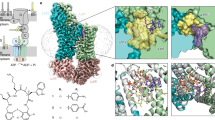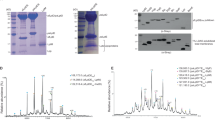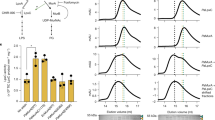Abstract
In the course of our screening for inhibitors of lipopolysaccharide (LPS) binding to cellular receptor CD14, potent inhibitory activity was detected in the cultured broth of Pedobacter sp. SANK 72003. Three active compounds, pedopeptin A, B and C, were isolated from the broth and their structures were elucidated by physicochemical and spectral data to be new cyclic depsipeptides.
Similar content being viewed by others
Log in or create a free account to read this content
Gain free access to this article, as well as selected content from this journal and more on nature.com
or
References
Wright, S. D., Ramos, R. A., Tobias, P. S., Ulevitch, R. J. & Mathison, J. C. CD14, a receptor for complexes of lipopolysaccharide (LPS) and LPS binding protein. Science 249, 1431–1433 (1990).
Kozuma, S. et al. Screeing and biological activities of pedopeptins, novel inhibitors of LPS produced by soil bacteria. J. Antibiot. 67, 237–242 (2014).
Gaillet, C., Lequart, C., Debeire, P. & Nuzillard, J. M. Band-selective HSQC and HMBC experiments using excitation sculpting and PFGSE. J. Magn. Reson. 139, 454–459 (1999).
Fujii, K., Shimoya, T., Ikai, Y., Oka, H. & Harada, K. Further application of advanced Marfey’s method for determination of absolute configuration of primary amino compound. Tetrahedron. Lett. 39, 2579–2582 (1998).
Steyn, P. L. et al. Classification of heparinolytic bacteria into a new genus, Pedobacter, comprising four species: Pedobacter heparinus comb. nov., Pedobacter piscium comb. nov., Pedobacter africanus sp. nov. and Pedobacter saltans sp. nov. proposal of the family Sphingobacteriaceae fam. nov. Int. J. Syst. Bacteriol. 48, 165–177 (1998).
Rasmussen, M. A., Madsen, S. M., Stouggard, P. & Johnsen, M. G. Flavobacterium sp. strain 4221 and Pedobacter sp. strain 4236 beta-1,3-glucanases that are active at low temperatures. Appl. Environ. Microbiol. 74, 7070–7072 (2008).
Shara, D. et al. Crystal structure of heparinase II from Pedobacter heparinus and its complex with a disaccharide product. J. Biol. Chem. 281, 15525–15535 (2006).
Margesin, R., Dieplinger, H., Hofmann, J., Sarg, B. & Lindner, H. A cold-active extracellular metalloprotease from Pedobacter cryoconitis—production and properties. Res. Microbiol. 156, 499–505 (2005).
Afonso, A., Hon, F. & Brambilla, R. Structure elucidation of Sch 20562, a glucoside cyclic dehydropeptide lactone—the major component of W-10 antifungal antibiotic. J. Antibiot. 52, 383–397 (1999).
Sano, T. & Kaya, K. Two new (E)-2-amino-2-butenoic acid (Dhb)-containing microcystins isolated from Oscillatoria agardhii. Tetrahedron 54, 463–470 (1998).
Namikoshi, M. et al. New nodularins: a general method for structure assignment. J. Org. Chem. 59, 2349–2357 (1994).
Kjaer, A. & Larsen, P. O. Amino acid studies. Part II. Structure and synthesis of albizziine (L-2-amino-3-ureidopropionic acid), an amino acid from higher plants. Acta. Chem. Scand. 13, 1565–1574 (1959).
Rao, S. L. N., Adiga, P. R. & Sarma, P. S. The isolation and characterization of β-N-oxalyl-L-α,β-diaminopropionic acid: a neurotoxin from the seeds of Lathyrus sativus. Biochemistry 3, 432–436 (1964).
Fusetani, N., Matsunaga, S., Matsumoto, H. & Takebayashi, Y. Cyclotheonamides, potent thrombin inhibitors, from a marine sponge Theonella sp. J. Am. Chem. Soc. 112, 7053–7054 (1990).
Storm, D. R., Rosenthal, K. S. & Swanson, P. E. Polymyxin and related peptide antibiotics. Annu. Rev. Biochem. 46, 723–763 (1977).
Rifkind, D. Prevention by polymyxin B of endotoxin lethality in mice. J. Bacteriol 93, 1463–1464 (1967).
Baldwin, G. et al. Effects of polymyxin B on experimental shock from Meningococcal and Escherichia coli endotoxins. J. Infect. Dis. 164, 542–549 (1991).
Sakura, N. et al. The contribution of the N-terminal structure of polymyxin B peptides to antimicrobial and lipopolysaccharide binding activity. Bull. Chem. Soc. Jpn 77, 1915–1924 (2004).
Kanazawa, K. et al. Contribution of each amino acid residue in polymyxin B3 to antimicrobial and lipopolysaccharide binding activity. Chem. Pharm. Bull. 57, 240–244 (2009).
Cowan, S. T. & Steel, K. J. in Cowan and Steel’s Manual for the Identification of Medical Bacteria 3rd edn (eds Barrow G. I., Feltham R. K. A) (Cambridge University Press: Cambridge, 1993).
Thompson, J. D., Higgins, D. G. & Gibson, T. J. CLUSTAL W: improving the sensitivity of progressive multiple sequence alignment through sequence weighting, position-specific gap penalties and weight matrix choice. Nucleic Acids Res. 22, 4673–4680 (1994).
Saitou, N. & Nei, M. The neighbor-joining method: a new method for reconstructing phylogenetic trees. Mol. Biol. Evol. 4, 406–425 (1987).
Acknowledgements
We are deeply grateful to Dr Toshio Takatsu for his useful advice and Mr Yasuyuki Takamatsu for isolation of the pedopeptins.
Author information
Authors and Affiliations
Corresponding author
Rights and permissions
About this article
Cite this article
Hirota-Takahata, Y., Kozuma, S., Kuraya, N. et al. Pedopeptins, novel inhibitors of LPS: Taxonomy of producing organism, fermentation, isolation, physicochemical properties and structural elucidation. J Antibiot 67, 243–251 (2014). https://doi.org/10.1038/ja.2013.122
Received:
Revised:
Accepted:
Published:
Issue date:
DOI: https://doi.org/10.1038/ja.2013.122
Keywords
This article is cited by
-
Nitrogen source as a modulator of the metabolic activity of Pedobacter lusitanus NL19: a transcriptomic approach
Applied Microbiology and Biotechnology (2022)
-
In-peptide amino acid racemization via inter-residue oxazoline intermediates during acidic hydrolysis
Amino Acids (2021)
-
Ogipeptins, novel inhibitors of LPS: physicochemical properties and structural elucidation
The Journal of Antibiotics (2017)
-
Identification and biological activity of ogipeptins, novel LPS inhibitors produced by marine bacterium
The Journal of Antibiotics (2017)



